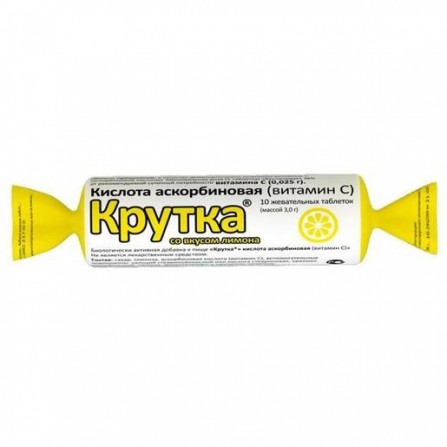Ascorbic acid pills with sugar 25mg N10
Condition: New product
1000 Items
Rating:
Be the first to write a review!

More info
Description
Ascorbic acid (vitamin C) is a drug belonging to the group of synthetic vitamins.
Active ingredients
Vitamin C
The brand
Twist
Release form
Pills
Composition
1 tablet: concentrate of phagolysate filtrate of pathogens of bacterial dysentery, lyophilized - 0.072 g, citrus pectin - 0.005 g, calcium gluconate - 0.016 g, glucose - 0.003 g, talc - 0.003 g, calcium stearate 1-water - 0.001 g
Pharmacological effect
Ascorbic acid has pronounced reducing properties, is involved in the regulation of carbohydrate metabolism, redox processes, blood clotting, normalization of capillary permeability, tissue regeneration, the synthesis of steroid hormones, collagen, procollagen.
Indications
It is used for prophylactic and therapeutic purposes in all clinical situations related to the need for additional administration of vitamin C. It is prescribed for the prevention and treatment of scurvy, for bleeding (nose, lung, uterine, caused by radiation sickness), hemorrhagic diathesis, for various intoxications and infectious diseases , nephropathies of pregnant women, Addison's disease, in case of overdose of anticoagulants, bone fractures and weakening wounds, various dystrophies, with increased mental stress and increased physical skom work.
Contraindications
Hypersensitivity, with prolonged use in large doses (over 500 mg) - diabetes, hyperoxaluria, nephrolithiasis, hemochromatosis, thalassemia, glucose-6-phosphate dehydrogenase deficiency.
Precautionary measures
With care: Sideroblastic anemia, urolithiasis.
Use during pregnancy and lactation
In pregnancy and lactation, they are used only if the intended benefit to the mother outweighs the potential risk to the fetus and child. The minimum daily need for ascorbic acid in the II-III trimesters of pregnancy is about 60 mg. It should be borne in mind that the fetus can adapt to high doses of ascorbic acid, which a pregnant woman is taking, and then the development of a "withdrawal" syndrome is possible in a newborn. The minimum daily need during lactation is 80 mg.A mother's diet that contains an adequate amount of ascorbic acid is sufficient to prevent its deficiency in an infant. Theoretically, there is a danger to the child when the mother uses high doses of ascorbic acid (it is recommended not to exceed the daily need for ascorbic acid by the nursing mother).
Dosage and administration
For prophylactic purposes, adults - at 0.05-0.1 g per day, during pregnancy, in the postpartum period and in the case of low content of vitamin C in the milk of lactating women - 0.3 g per day for 10-15 days, then prophylactically - 0.1 g per day during the entire period of lactation. Children in order to prevent - 0.025 g 2-3 times a day. Therapeutic doses for adults - 0.05-0.1 g 3-5 times a day. Children - at 0.05-0.1 g 2-3 times a day.
Side effects
On the part of the central nervous system: with rapid intravenous administration - dizziness, fatigue, with prolonged use of large doses (more than 1 g) - headache, increased excitability of the central nervous system, insomnia. From the urinary system: moderate pollakiuria (with a dose of more than 600 mg / day), with long-term use of large doses - hyperoxaluria, nephrolithiasis (from calcium oxalate), damage to the glomerular apparatus of the kidneys. From the side of the cardiovascular system: with prolonged use pain their doses - reducing capillary permeability (possible deterioration of tissue trophism, increased blood pressure, hypercoagulation, development of microangiopathy) .Allergicheskie reaction: allergic reactions until the development of anaphylactic shoka.Laboratornye indices: thrombocytosis, giperprotrombinemiya, erythropenia, leukocytosis, hypokalemia, glycosuria.
Interaction with other drugs
Pharmaceuticals are not compatible with amines included in oral contraceptives). Reduces the effectiveness of heparin and indirect anticoagulants. With simultaneous use with acetylsalicylic acid, urine excretion of ascorbic acid increases and excretion of acetylsalicylic acid decreases. Increases the risk of crystalluria in the treatment of short-acting salicylates and sulfonamides,slows kidney excretion of acids, increases the excretion of drugs having an alkaline reaction (including alkaloids), reduces the concentration in the blood of oral contraceptives. Increases the overall clearance of ethanol, which in turn reduces the concentration of ascorbic acid in the body. Drugs of the quinoline series, calcium supplements, salicylates, glucocorticosteroids with long-term use deplete reserves of ascorbic acid. doses may interfere with the interaction of disulfiram and ethanol. In high doses, increases the excretion of meksiletina kidneys. Barbiturates and primidone increase the excretion of ascorbic acid in the urine. Reduces the therapeutic effect of antipsychotic drugs (neuroleptics) - phenothiazine derivatives, tubular reabsorption of amphetamine and tricyclic antidepressants.
special instructions
Due to the stimulating effect of ascorbic acid on the synthesis of corticosteroid hormones, it is necessary to monitor the function of the adrenal glands and blood pressure. High doses of ascorbic acid increase the excretion of oxalate, contributing to the formation of kidney stones. In newborns whose mothers took high doses of ascorbic acid, and in adults who took high doses, a ricochet of scurvy could be observed. With long-term use of large doses, the function of the insular apparatus of the pancreas may be inhibited, therefore during treatment it must be regularly monitored. In patients with a high content of iron in the body, ascorbic acid should be used in minimal doses. Ascorbic acid, as a reducing agent, can distort the results of various laboratory tests (blood and urine glucose, bilirubin, liver transaminases and lactate dehydrogenase activity). Impact on ability to drive motor vehicles and control mechanisms During the period of treatment, care must be taken when driving and exercising potentially hazardous activities that require increased concentration of attention and quickness of psychomotor reactions.



